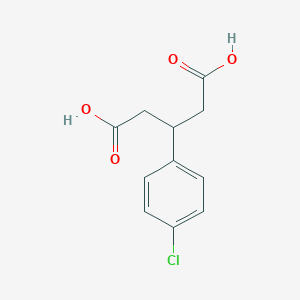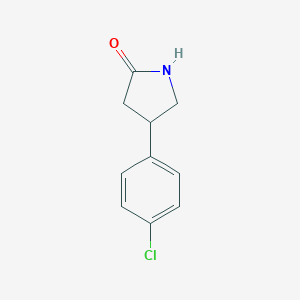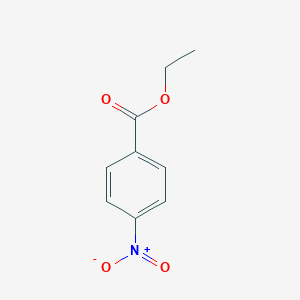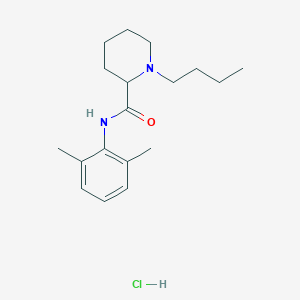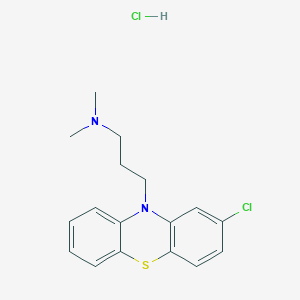
Chlorpromazine hydrochloride
概要
説明
クロルプロマジン塩酸塩は、中枢神経系を抑制する脳の高次中枢に選択的に作用する強力な合成鎮静薬です。 主に統合失調症、躁うつ病、小児の重度の行動問題、悪心と嘔吐、手術前の不安、持続的なしゃっくりなどの精神病の治療に使用されます .
作用機序
クロルプロマジン塩酸塩は、主にドパミン受容体拮抗薬として作用します。脳内のドパミン受容体、特にD2受容体に結合して遮断し、ドパミンシグナル伝達経路の活性を低下させます。この作用は、抗精神病作用の原因であると考えられています。 さらに、クロルプロマジン塩酸塩は、抗セロトニン作用と抗ヒスタミン作用を示し、全体的な治療効果に寄与しています .
生化学分析
Biochemical Properties
Chlorpromazine hydrochloride plays a crucial role in biochemical reactions by acting as an antagonist on various postsynaptic receptors. It primarily interacts with dopaminergic receptors (subtypes D1, D2, D3, and D4), serotonergic receptors (5-HT1 and 5-HT2), histaminergic receptors (H1 and H2), and muscarinic receptors (M1 and M2) . These interactions result in the modulation of neurotransmitter activity, leading to its antipsychotic, antiemetic, and sedative effects.
Cellular Effects
This compound exerts significant effects on various types of cells and cellular processes. It influences cell function by modulating cell signaling pathways, gene expression, and cellular metabolism. For instance, this compound can initiate cell death in both cancerous and healthy liver cells by inducing apoptosis . Additionally, it affects neurogenesis in the rat brain by decreasing the number of Sox-2-expressing stem cells and early neural progenitors .
Molecular Mechanism
The molecular mechanism of this compound involves its action as an antagonist on different postsynaptic receptors. It blocks dopaminergic receptors, leading to a reduction in dopamine activity, which is associated with its antipsychotic properties . This compound also inhibits serotonergic, histaminergic, and muscarinic receptors, contributing to its anxiolytic, antidepressive, and antiaggressive effects . These interactions result in changes in gene expression and enzyme activity, further influencing cellular functions.
Temporal Effects in Laboratory Settings
In laboratory settings, the effects of this compound change over time. The compound exhibits multicompartmental pharmacokinetics, with a half-life of approximately 11.05 hours . It undergoes extensive first-pass metabolism, leading to significant variability in its pharmacokinetics. Over time, this compound can degrade, affecting its stability and long-term impact on cellular functions .
Dosage Effects in Animal Models
The effects of this compound vary with different dosages in animal models. At therapeutic doses, it can cause side effects such as orthostatic hypotension, jaundice, and leukopenia . High doses may lead to toxic effects, including interference with pituitary-gonadal function and neurogenic stem/progenitor cell formation . These dosage-dependent effects highlight the importance of careful dosage management in clinical settings.
Metabolic Pathways
This compound is involved in several metabolic pathways, primarily catalyzed by cytochrome P450 isoenzymes. The main metabolic mechanisms include N-demethylation, S-oxidation, and aromatic hydroxylation . These pathways result in the formation of various metabolites, such as mono-N-desmethylchlorpromazine, chlorpromazine sulfoxide, and 7-hydroxychlorpromazine . These metabolites can further undergo phase II metabolism, including glucuronidation and sulfation .
Transport and Distribution
This compound is transported and distributed within cells and tissues through various mechanisms. It exhibits wide distribution in the body, with a volume of distribution at steady state of approximately 642 liters . The compound is highly protein-bound, with 90-99% of it bound to plasma proteins . This extensive binding affects its localization and accumulation in different tissues.
Subcellular Localization
The subcellular localization of this compound is influenced by its interactions with various biomolecules. It can localize to different cellular compartments, including the cytoplasm and cell membrane. The compound’s activity and function are affected by its localization, as it can interact with specific receptors and enzymes within these compartments . Post-translational modifications, such as phosphorylation, may also play a role in directing this compound to specific organelles.
準備方法
合成経路と反応条件
クロルプロマジン塩酸塩は、複数段階のプロセスで合成されます。合成は、2-クロロフェノチアジンと3-ジメチルアミノプロピルクロリドを、ナトリウムアミドなどの塩基の存在下で反応させることから始まります。 この反応により、クロルプロマジンが生成され、その後、塩酸で処理することにより、塩酸塩に変換されます .
工業的生産方法
工業的な設定では、クロルプロマジン塩酸塩は、同様の合成経路を使用して、より大規模に製造されます。このプロセスには、特定の条件下で、クロルプロマジンを、微結晶セルロース、乳糖一水和物、予め糊化したデンプン、コロイド状二酸化ケイ素、ステアリン酸マグネシウムと混合することが含まれます。 次に、混合物をふるいにかけて圧縮して、最終的な医薬品製剤を得ます .
化学反応の分析
反応の種類
クロルプロマジン塩酸塩は、酸化、還元、置換反応を含む、さまざまな化学反応を起こします。
一般的な試薬と条件
酸化: クロルプロマジン塩酸塩は、酸性条件下で、過マンガン酸カリウムや過酸化水素などの試薬を使用して酸化することができます。
還元: 還元は、水素化リチウムアルミニウムや水素化ホウ素ナトリウムなどの試薬を使用して達成することができます。
置換: 置換反応には、多くの場合、塩基性条件下で、水酸化物イオンやアミンなどの求核剤が関与します。
主な生成物
これらの反応から生成される主な生成物には、クロルプロマジンスルホキシド(酸化)、還元されたクロルプロマジン(還元)、およびさまざまな置換誘導体(置換)が含まれます .
科学研究への応用
クロルプロマジン塩酸塩は、さまざまな科学研究への応用範囲があります。
科学的研究の応用
Chlorpromazine hydrochloride has a wide range of scientific research applications:
類似化合物との比較
クロルプロマジン塩酸塩は、フェノチアジン系抗精神病薬に属します。類似の化合物には、以下が含まれます。
プロマジン: クロルプロマジンと同様の作用機序を持つ別のフェノチアジン系抗精神病薬ですが、クロルプロマジンほど強力ではありません.
チオリダジン: 抗精神病作用は類似していますが、副作用のプロファイルが異なるフェノチアジン誘導体です。
フルフェナジン: 統合失調症の治療に使用される、より強力なフェノチアジン系抗精神病薬です。
クロルプロマジン塩酸塩は、小児の重度の行動問題の治療や、悪心と嘔吐の抑制における有効性など、幅広い治療用途を持つ点でユニークです .
特性
IUPAC Name |
3-(2-chlorophenothiazin-10-yl)-N,N-dimethylpropan-1-amine;hydrochloride | |
|---|---|---|
| Source | PubChem | |
| URL | https://pubchem.ncbi.nlm.nih.gov | |
| Description | Data deposited in or computed by PubChem | |
InChI |
InChI=1S/C17H19ClN2S.ClH/c1-19(2)10-5-11-20-14-6-3-4-7-16(14)21-17-9-8-13(18)12-15(17)20;/h3-4,6-9,12H,5,10-11H2,1-2H3;1H | |
| Source | PubChem | |
| URL | https://pubchem.ncbi.nlm.nih.gov | |
| Description | Data deposited in or computed by PubChem | |
InChI Key |
FBSMERQALIEGJT-UHFFFAOYSA-N | |
| Source | PubChem | |
| URL | https://pubchem.ncbi.nlm.nih.gov | |
| Description | Data deposited in or computed by PubChem | |
Canonical SMILES |
CN(C)CCCN1C2=CC=CC=C2SC3=C1C=C(C=C3)Cl.Cl | |
| Source | PubChem | |
| URL | https://pubchem.ncbi.nlm.nih.gov | |
| Description | Data deposited in or computed by PubChem | |
Molecular Formula |
C17H19ClN2S.ClH, C17H20Cl2N2S | |
| Record name | CHLORPROMAZINE HYDROCHLORIDE | |
| Source | CAMEO Chemicals | |
| URL | https://cameochemicals.noaa.gov/chemical/20027 | |
| Description | CAMEO Chemicals is a chemical database designed for people who are involved in hazardous material incident response and planning. CAMEO Chemicals contains a library with thousands of datasheets containing response-related information and recommendations for hazardous materials that are commonly transported, used, or stored in the United States. CAMEO Chemicals was developed by the National Oceanic and Atmospheric Administration's Office of Response and Restoration in partnership with the Environmental Protection Agency's Office of Emergency Management. | |
| Explanation | CAMEO Chemicals and all other CAMEO products are available at no charge to those organizations and individuals (recipients) responsible for the safe handling of chemicals. However, some of the chemical data itself is subject to the copyright restrictions of the companies or organizations that provided the data. | |
| Source | PubChem | |
| URL | https://pubchem.ncbi.nlm.nih.gov | |
| Description | Data deposited in or computed by PubChem | |
DSSTOX Substance ID |
DTXSID7024827 | |
| Record name | Chlorpromazine hydrochloride | |
| Source | EPA DSSTox | |
| URL | https://comptox.epa.gov/dashboard/DTXSID7024827 | |
| Description | DSSTox provides a high quality public chemistry resource for supporting improved predictive toxicology. | |
Molecular Weight |
355.3 g/mol | |
| Source | PubChem | |
| URL | https://pubchem.ncbi.nlm.nih.gov | |
| Description | Data deposited in or computed by PubChem | |
Physical Description |
Chlorpromazine hydrochloride appears as white or creamy-white odorless crystalline powder with very bitter taste. pH (5% aqueous solution) 4.0-5.5. pH (10% aqueous solution) 4-5. (NTP, 1992) | |
| Record name | CHLORPROMAZINE HYDROCHLORIDE | |
| Source | CAMEO Chemicals | |
| URL | https://cameochemicals.noaa.gov/chemical/20027 | |
| Description | CAMEO Chemicals is a chemical database designed for people who are involved in hazardous material incident response and planning. CAMEO Chemicals contains a library with thousands of datasheets containing response-related information and recommendations for hazardous materials that are commonly transported, used, or stored in the United States. CAMEO Chemicals was developed by the National Oceanic and Atmospheric Administration's Office of Response and Restoration in partnership with the Environmental Protection Agency's Office of Emergency Management. | |
| Explanation | CAMEO Chemicals and all other CAMEO products are available at no charge to those organizations and individuals (recipients) responsible for the safe handling of chemicals. However, some of the chemical data itself is subject to the copyright restrictions of the companies or organizations that provided the data. | |
Solubility |
greater than or equal to 100 mg/mL at 75 °F (NTP, 1992) | |
| Record name | CHLORPROMAZINE HYDROCHLORIDE | |
| Source | CAMEO Chemicals | |
| URL | https://cameochemicals.noaa.gov/chemical/20027 | |
| Description | CAMEO Chemicals is a chemical database designed for people who are involved in hazardous material incident response and planning. CAMEO Chemicals contains a library with thousands of datasheets containing response-related information and recommendations for hazardous materials that are commonly transported, used, or stored in the United States. CAMEO Chemicals was developed by the National Oceanic and Atmospheric Administration's Office of Response and Restoration in partnership with the Environmental Protection Agency's Office of Emergency Management. | |
| Explanation | CAMEO Chemicals and all other CAMEO products are available at no charge to those organizations and individuals (recipients) responsible for the safe handling of chemicals. However, some of the chemical data itself is subject to the copyright restrictions of the companies or organizations that provided the data. | |
CAS No. |
69-09-0 | |
| Record name | CHLORPROMAZINE HYDROCHLORIDE | |
| Source | CAMEO Chemicals | |
| URL | https://cameochemicals.noaa.gov/chemical/20027 | |
| Description | CAMEO Chemicals is a chemical database designed for people who are involved in hazardous material incident response and planning. CAMEO Chemicals contains a library with thousands of datasheets containing response-related information and recommendations for hazardous materials that are commonly transported, used, or stored in the United States. CAMEO Chemicals was developed by the National Oceanic and Atmospheric Administration's Office of Response and Restoration in partnership with the Environmental Protection Agency's Office of Emergency Management. | |
| Explanation | CAMEO Chemicals and all other CAMEO products are available at no charge to those organizations and individuals (recipients) responsible for the safe handling of chemicals. However, some of the chemical data itself is subject to the copyright restrictions of the companies or organizations that provided the data. | |
| Record name | Chlorpromazine hydrochloride | |
| Source | CAS Common Chemistry | |
| URL | https://commonchemistry.cas.org/detail?cas_rn=69-09-0 | |
| Description | CAS Common Chemistry is an open community resource for accessing chemical information. Nearly 500,000 chemical substances from CAS REGISTRY cover areas of community interest, including common and frequently regulated chemicals, and those relevant to high school and undergraduate chemistry classes. This chemical information, curated by our expert scientists, is provided in alignment with our mission as a division of the American Chemical Society. | |
| Explanation | The data from CAS Common Chemistry is provided under a CC-BY-NC 4.0 license, unless otherwise stated. | |
| Record name | Chlorpromazine hydrochloride [USP:BAN:JAN] | |
| Source | ChemIDplus | |
| URL | https://pubchem.ncbi.nlm.nih.gov/substance/?source=chemidplus&sourceid=0000069090 | |
| Description | ChemIDplus is a free, web search system that provides access to the structure and nomenclature authority files used for the identification of chemical substances cited in National Library of Medicine (NLM) databases, including the TOXNET system. | |
| Record name | Chlorpromazine hydrochloride | |
| Source | DTP/NCI | |
| URL | https://dtp.cancer.gov/dtpstandard/servlet/dwindex?searchtype=NSC&outputformat=html&searchlist=17479 | |
| Description | The NCI Development Therapeutics Program (DTP) provides services and resources to the academic and private-sector research communities worldwide to facilitate the discovery and development of new cancer therapeutic agents. | |
| Explanation | Unless otherwise indicated, all text within NCI products is free of copyright and may be reused without our permission. Credit the National Cancer Institute as the source. | |
| Record name | 10H-Phenothiazine-10-propanamine, 2-chloro-N,N-dimethyl-, hydrochloride (1:1) | |
| Source | EPA Chemicals under the TSCA | |
| URL | https://www.epa.gov/chemicals-under-tsca | |
| Description | EPA Chemicals under the Toxic Substances Control Act (TSCA) collection contains information on chemicals and their regulations under TSCA, including non-confidential content from the TSCA Chemical Substance Inventory and Chemical Data Reporting. | |
| Record name | Chlorpromazine hydrochloride | |
| Source | EPA DSSTox | |
| URL | https://comptox.epa.gov/dashboard/DTXSID7024827 | |
| Description | DSSTox provides a high quality public chemistry resource for supporting improved predictive toxicology. | |
| Record name | Chlorpromazine hydrochloride | |
| Source | European Chemicals Agency (ECHA) | |
| URL | https://echa.europa.eu/substance-information/-/substanceinfo/100.000.638 | |
| Description | The European Chemicals Agency (ECHA) is an agency of the European Union which is the driving force among regulatory authorities in implementing the EU's groundbreaking chemicals legislation for the benefit of human health and the environment as well as for innovation and competitiveness. | |
| Explanation | Use of the information, documents and data from the ECHA website is subject to the terms and conditions of this Legal Notice, and subject to other binding limitations provided for under applicable law, the information, documents and data made available on the ECHA website may be reproduced, distributed and/or used, totally or in part, for non-commercial purposes provided that ECHA is acknowledged as the source: "Source: European Chemicals Agency, http://echa.europa.eu/". Such acknowledgement must be included in each copy of the material. ECHA permits and encourages organisations and individuals to create links to the ECHA website under the following cumulative conditions: Links can only be made to webpages that provide a link to the Legal Notice page. | |
| Record name | CHLORPROMAZINE HYDROCHLORIDE | |
| Source | FDA Global Substance Registration System (GSRS) | |
| URL | https://gsrs.ncats.nih.gov/ginas/app/beta/substances/9WP59609J6 | |
| Description | The FDA Global Substance Registration System (GSRS) enables the efficient and accurate exchange of information on what substances are in regulated products. Instead of relying on names, which vary across regulatory domains, countries, and regions, the GSRS knowledge base makes it possible for substances to be defined by standardized, scientific descriptions. | |
| Explanation | Unless otherwise noted, the contents of the FDA website (www.fda.gov), both text and graphics, are not copyrighted. They are in the public domain and may be republished, reprinted and otherwise used freely by anyone without the need to obtain permission from FDA. Credit to the U.S. Food and Drug Administration as the source is appreciated but not required. | |
Melting Point |
378 to 385 °F (decomposes) (NTP, 1992) | |
| Record name | CHLORPROMAZINE HYDROCHLORIDE | |
| Source | CAMEO Chemicals | |
| URL | https://cameochemicals.noaa.gov/chemical/20027 | |
| Description | CAMEO Chemicals is a chemical database designed for people who are involved in hazardous material incident response and planning. CAMEO Chemicals contains a library with thousands of datasheets containing response-related information and recommendations for hazardous materials that are commonly transported, used, or stored in the United States. CAMEO Chemicals was developed by the National Oceanic and Atmospheric Administration's Office of Response and Restoration in partnership with the Environmental Protection Agency's Office of Emergency Management. | |
| Explanation | CAMEO Chemicals and all other CAMEO products are available at no charge to those organizations and individuals (recipients) responsible for the safe handling of chemicals. However, some of the chemical data itself is subject to the copyright restrictions of the companies or organizations that provided the data. | |
Retrosynthesis Analysis
AI-Powered Synthesis Planning: Our tool employs the Template_relevance Pistachio, Template_relevance Bkms_metabolic, Template_relevance Pistachio_ringbreaker, Template_relevance Reaxys, Template_relevance Reaxys_biocatalysis model, leveraging a vast database of chemical reactions to predict feasible synthetic routes.
One-Step Synthesis Focus: Specifically designed for one-step synthesis, it provides concise and direct routes for your target compounds, streamlining the synthesis process.
Accurate Predictions: Utilizing the extensive PISTACHIO, BKMS_METABOLIC, PISTACHIO_RINGBREAKER, REAXYS, REAXYS_BIOCATALYSIS database, our tool offers high-accuracy predictions, reflecting the latest in chemical research and data.
Strategy Settings
| Precursor scoring | Relevance Heuristic |
|---|---|
| Min. plausibility | 0.01 |
| Model | Template_relevance |
| Template Set | Pistachio/Bkms_metabolic/Pistachio_ringbreaker/Reaxys/Reaxys_biocatalysis |
| Top-N result to add to graph | 6 |
Feasible Synthetic Routes
Q1: What is the primary mechanism of action of Chlorpromazine Hydrochloride?
A1: this compound primarily acts as a dopamine antagonist, blocking the action of dopamine in the brain. This is thought to be responsible for its antipsychotic effects. []
Q2: How does this compound affect prolactin levels?
A2: this compound can stimulate prolactin release in rats, with peak levels observed between 30 and 90 minutes after administration. This effect is dose-dependent and correlates with the drug's antipsychotic potency in humans. []
Q3: Does this compound impact bile secretion?
A3: Yes, this compound can induce cholestasis, a condition characterized by reduced bile flow. This effect is likely due to the drug's ability to form insoluble complexes with bile salts, leading to their precipitation and reduced secretion. [] Studies in Rhesus monkeys demonstrate that this effect is dose-dependent and reversible, with bile flow returning to normal as drug concentrations decrease. []
Q4: What is the molecular formula and weight of this compound?
A4: The molecular formula of this compound is C17H19ClN2S·HCl, and its molecular weight is 355.33 g/mol.
Q5: Does this compound interact with lipids?
A5: Yes, being an amphiphilic molecule, this compound can interact with both polar and non-polar molecules. Studies show that it can interact with bile lipids, forming insoluble complexes with bile salts and solubilizing membrane phospholipids like phosphatidylserine and phosphatidylcholine. []
Q6: How does the structure of this compound contribute to its interaction with bile salts?
A6: this compound is amphiphilic due to its polar tertiary amine group linked to a hydrophobic tricyclic ring system by a short paraffin chain. This structure allows it to interact with both the hydrophilic and hydrophobic regions of bile salts, leading to complex formation and precipitation. []
Q7: Does the sugar-coating on this compound tablets interfere with content determination?
A7: No, studies have shown that the sugar-coating does not interfere with UV spectrophotometric determination of this compound content in tablets. Therefore, shelling the sugar-coat is unnecessary for accurate analysis. []
Q8: What is the impact of this compound on regional blood flow in acute cerebral infarction patients?
A8: Studies show that this compound, particularly when combined with ozagrel, can significantly improve regional blood flow speed in acute cerebral infarction patients. This combination also effectively reduces blood viscosity. []
Q9: What effect does this compound have on diffuse large B lymphoma cells?
A9: In vitro studies show that this compound can inhibit the proliferation of diffuse large B lymphoma cells, potentially by promoting the expression of S1PR2. It also induces apoptosis and promotes G1 cell cycle arrest in these cells. []
Q10: Has this compound shown efficacy in treating intractable hiccups?
A10: Yes, clinical observations suggest that this compound is effective in treating intractable hiccups, showing positive results through various administration routes like acupoint injection, nasal mucosa medication, and combined with traditional Chinese medicine. [, , ]
Q11: What analytical methods are commonly employed for this compound quantification?
A11: Several analytical methods are used for this compound quantification, including:
- Spectrophotometry: This method relies on the drug's absorbance at specific wavelengths, but it can be influenced by excipients or degradation products. [, , , , , , , , ]
- Spectrofluorimetry: This method measures the drug's fluorescence intensity, offering high sensitivity and a low detection limit. [, ]
- Chemiluminescence: This technique exploits the light emitted during a chemical reaction involving the drug, offering high sensitivity. [, ]
- High-performance liquid chromatography (HPLC): This method separates the drug from other components in a sample before detection, offering high selectivity and sensitivity. [, ]
- Ultra performance liquid chromatography-tandem mass spectrometry (UPLC/MS/MS): This method combines the separation power of HPLC with the sensitivity and selectivity of mass spectrometry. []
- Flow injection analysis: This technique automates sample injection and analysis, improving speed and precision. [, , , ]
- Resonance scattering spectrometry: This method measures the scattering of light by nanoparticles formed upon reaction with the drug, offering high sensitivity and selectivity. []
Q12: Are there specific challenges in analyzing this compound in biological samples?
A12: Yes, biological matrices can introduce interferences, requiring extraction and cleanup procedures before analysis. Methods like UPLC/MS/MS are particularly useful for analyzing trace levels in complex matrices like animal tissues. []
Q13: How do analytical methods ensure accurate and reliable determination of this compound?
A13: Analytical methods undergo validation to ensure their accuracy, precision, and specificity for this compound determination. This involves assessing parameters like linearity, range, limit of detection, limit of quantification, and recovery. [, , , , , , , , , ]
試験管内研究製品の免責事項と情報
BenchChemで提示されるすべての記事および製品情報は、情報提供を目的としています。BenchChemで購入可能な製品は、生体外研究のために特別に設計されています。生体外研究は、ラテン語の "in glass" に由来し、生物体の外で行われる実験を指します。これらの製品は医薬品または薬として分類されておらず、FDAから任何の医療状態、病気、または疾患の予防、治療、または治癒のために承認されていません。これらの製品を人間または動物に体内に導入する形態は、法律により厳格に禁止されています。これらのガイドラインに従うことは、研究と実験において法的および倫理的な基準の遵守を確実にするために重要です。


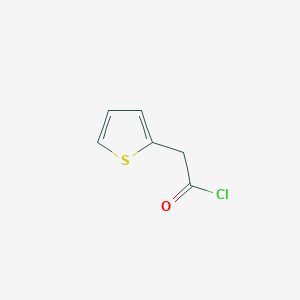
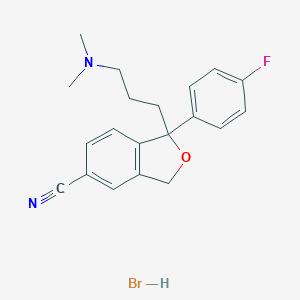
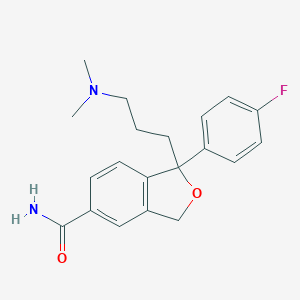
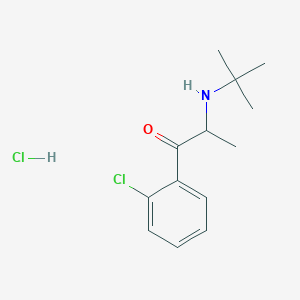


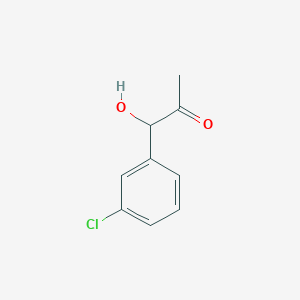

![5-[3-(dimethylamino)propyl]-5H-dibenzo[a,d]cyclohepten-5-ol](/img/structure/B195662.png)

